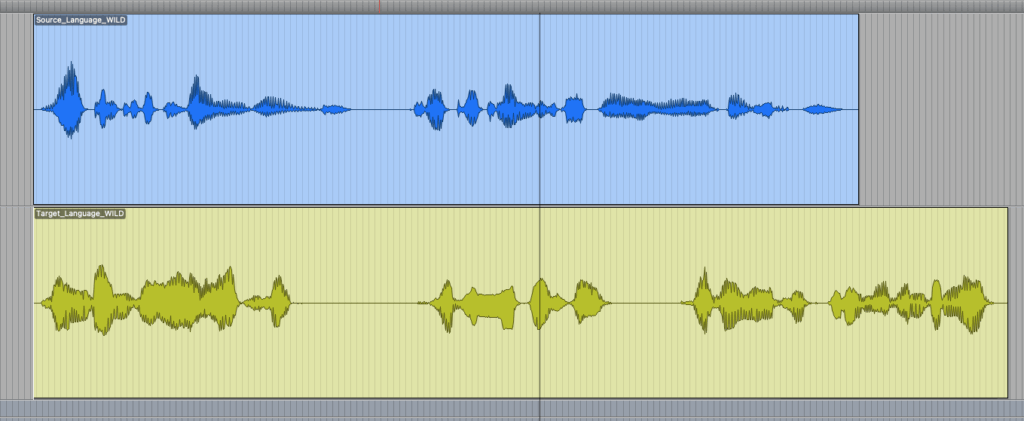At G-angle, we specialize in bringing games to life through professional voice recording and audio localization. With more than 7,000 recording sessions every year, our team works closely with developers and publishers around the world to ensure that characters sound authentic, natural, and emotionally engaging.

In this article, we’ll explore the key stages of game audio localization and share insights on how to avoid common pitfalls based on our experience in the industry. From understanding costs to preparing casting briefs and formatting scripts, being ready in these areas helps streamline production, reduce expenses, and build stronger partnerships between studios and vendors. Although audio localization is a pivotal part of video game development, reliable information on the process can be difficult to find, which is why we’re here to help.

Audio Localization Costs
In most game projects, audio accounts for one of the largest portions of the overall localization budget. Unlike text, it is not just a matter of translation: it involves casting actors, guiding performances through experienced voice directors, engineering high-quality recordings, and coordinating production across multiple teams and facilities.
It is a significant investment, but one that directly impacts how players experience the game. Flat performances or poor sound quality can undo months of careful writing and design. That is why it is important to allocate resources toward:
- Talented voice actors who can bring characters to life
- Directors who understand the rhythm and emotion of interactive storytelling
- A seasoned production team to oversee schedules, contracts, and asset delivery
For larger-scale projects or multi-language releases, dedicated production management becomes essential. This ensures that everything from casting to final delivery stays on track and maintains quality and consistency across versions.
Several key elements influence the overall cost of audio localization. These include the number of words or lines to be recorded, the type of timing constraints placed on each line, the complexity of the sync requirements, and the level of voice talent involved.
The more prepared you are before recording begins, the smoother the process will be. Unexpected changes or delays during production almost always increase both costs and timelines, so clear planning is essential.
To create an accurate and reliable quote, a vendor will typically need the following details:
- Total line and word count – the complete volume of dialogue to be recorded.
- Breakdown by category – an indication of whether lines require lip-sync, have specific timing constraints, or are wild (recorded freely without timing restrictions).
- Character details – the number of characters, character briefs, their roles (main, minor, NPC), and word count per character.
- Game genre considerations – for example, a samurai-era title may require authentic Edo-period speech patterns or regional dialects.
- Casting method – database casting or audition-based casting, with the latter generally requiring more time and budget.
- Number of actors – which may differ from the number of characters in the original script.
- Target platforms – the systems or devices where the localized game will be released.
- Target regions – the parts of the world in which the localized audio will be available.

Types of Voiceover Lines
The type of voiceover recording required can have a major impact on both cost and production time. At the core of this is sync status; whether the localized audio must match the timing of the original or align directly with visuals.
- Non-sync VO: Flexible lines such as barks (grunts, sighs, or shouts), short one-liners, or NPC background dialogue. These are generally faster and more cost-efficient to record.
- Scripted and cinematic VO: Narrative-heavy dialogue, cutscenes, and scripted events require close synchronization, which increases both production time and cost.
The stricter the requirement, the longer recording sessions take and the higher the costs. This is particularly true when localizing from English into Japanese, where differences in sentence structure and duration make timing alignment more complex than in many other language pairs.
This is where defining all of your recording constraints becomes essential. Since the studio team will only have access to the audio file as reference, every time constraint must be set in relation to the source audio. The stricter the constraint, the more carefully performances must be timed, and the fewer lines that can be recorded in an hour.
It is also worth noting that terminology can vary slightly from vendor to vendor, but the underlying principles remain consistent across the industry. The line-per-hour figures below are estimates based on G-angle’s experience handling thousands of recording sessions each year:
- Wild – Around 100 lines per hour. No time constraints. Dialogue can run naturally, often used for tutorials, narration, or ambient NPC dialogue where the speaker isn’t clearly visible.
- Loose Time Constraints (+/- 20%) – Around 80 lines per hour. The localized audio may be shorter or longer than the source, within a 20% margin.
- Soft Time Constraints (+/- 10%) – Around 50 lines per hour. The localized audio must be very close in length to the source, within a 10% margin.
- Strict Time Constraints (0%) – Around 30 lines per hour. The localized audio must match the source length exactly, with no flexibility.
- Sound Sync – Around 10–15 lines per hour. The recording must follow the internal pauses and silences of the source audio.
- Lip Sync – Around 10–15 lines per hour. The recording must match the mouth movements shown in the visuals, typically required in close-up cutscenes.
Because the only reference available is the source audio, every localized line must be checked against its original counterpart. This makes it crucial to set recording constraints early in the process, ensuring that budgets and schedules are aligned with the true demands of the project. To give a clearer picture of how these constraints work in practice, we will show examples of each type in the pictures below, taken directly at our studio.
WILD

Source_Language_WILD
Target_Language_WILD
LOOSE TIME-CONSTRAINTS (+/- 20%)

Source_Language_TC20%
Target_Language_TC20%
SOFT TIME-CONSTRAINTS (+/- 10%)

Source_Language_TC10%
Target_Language_TC10%
STRICT TIME-CONSTRAINTS (0%)

Source_Language_TC0%
Target_Language_TC0%
SOUND SYNC/LIP SYNC

Source_Language_SS
Target_Language_SS

Character & Casting Documents
Clear and detailed casting documentation is one of the most effective ways to avoid production issues. The casting brief, which provides all the essential information about each character, often looks simple on the surface. But the reality is more complex, and overlooking small details can cause major inconsistencies later on.
One of the biggest challenges comes from speech styles. A character written with a specific accent or way of speaking, such as rural dialects, regional slang, or a laid-back “surfer” tone, cannot always be reproduced naturally in another language. The same applies to humor, which often relies on cultural context, wordplay, or double meanings. What feels witty and engaging in the source language may not translate cleanly, so a careful adaptation that focuses on intent rather than literal meaning is essential.
Regional references can also create hurdles. Phrases or expressions that feel natural to the original audience might not carry the same weight in another culture, and these cases should be openly reviewed with the localization partner to find alternatives that preserve the story’s impact.
Casting by age is another area that requires sensitivity. For instance, Japanese audiences often perceive English voices as sounding older than the same characters would in Japanese. Adjusting for these cultural expectations is important to ensure that players connect with characters in the way the creators intended.
Script Formatting
Well-prepared scripts are the backbone of an efficient recording session. Since lines often change during production, a clear and adaptable format is essential to keep everything organized.
Most studios rely on Excel or Google Sheets for this purpose, often with macros to handle updates, alternate takes, time stamps, and version control. A strong script should include:
- Unique line IDs in chronological order, so that nothing gets lost or duplicated.
- Story context and director’s notes that explain the situation in which the dialogue takes place. This helps actors deliver lines with the right emotion and tone.
- Consistent pronunciation guides for character names or unique terminology, which is especially important in fantasy and sci-fi settings.
- Line type labels (wild, time-constrained, sync, etc.), so the recording team understands the timing requirements before stepping into the booth.
Organizing lines in chronological order also gives actors the ability to perform conversations naturally, rather than jumping back and forth across disconnected scenes. This results in smoother, more believable performances.
Another critical element of script management is leaving space for an As-Recorded (As-Rec) script. Lines that are intended to sync with master audio often require careful adaptation, sometimes shortened and sometimes lengthened, to fit lip flap or timing requirements. This is particularly true when working between structurally different languages like Japanese and English, where direct translations rarely align perfectly with the source.
Because of these differences, it is very common for adjustments to happen live in the studio. When that occurs, every change needs to be logged in the As-Rec script along with notes from the recording team. This documentation ensures that QA, LQA, and subtitling teams have a clear reference point for what was actually recorded, preventing inconsistencies later in the process.

Post-production and QA Requirements
With thousands of recording sessions moving through our studio every year, we’ve seen firsthand how post-production and quality assurance can make or break a project. The sheer volume of files combined with fast turnaround times means that asset management must be precise. Even small issues, such as an incorrect file name or an extra pause in the audio, can create setbacks during integration. For a seamless recording and delivery process, studios should make sure the following requirements are clearly defined and consistently applied:
- File formats
- Naming conventions
- Sample and bit rates
- Folder structure
- Audio editing requirements to remove silences, clicks, or other unwanted noise
- Compression, normalization, and effects processing
- Loudness levels for mastering
However, don’t worry if you don’t have a technical background in audio at this stage. The right audio localization partner will walk you through the process, sharing best practices and suggesting specifications suited for your game, its genre, and your target players.

Conclusion
Game audio localization is a complex process, but with the right preparation and guidance it can become a smooth and rewarding part of development. We’ve shared some of the key factors to keep in mind, from casting to script formatting and post-production.
What do you think about these insights? Have you run into similar challenges in your own projects? We’d love to hear your perspective.
If you have any questions about the topics we covered, or if you’d like to discuss how these practices might apply to your upcoming game, feel free to reach out to us. Our team at G-angle is here to support you every step of the way.




